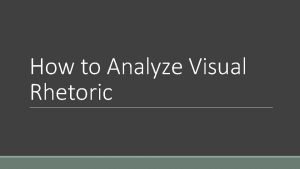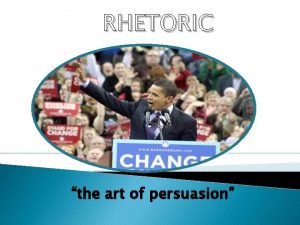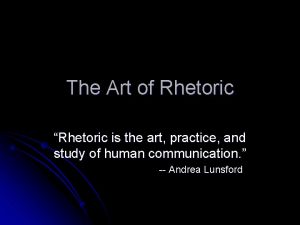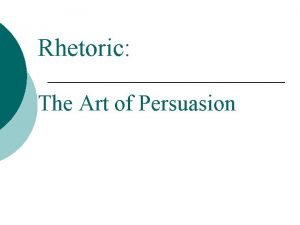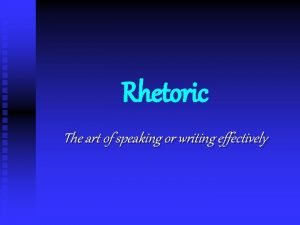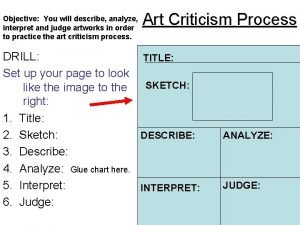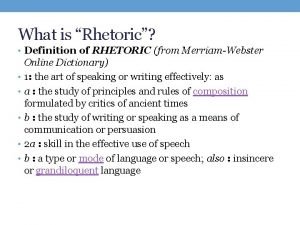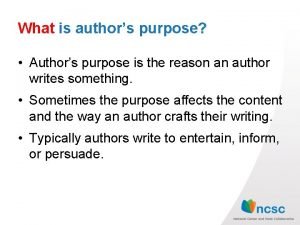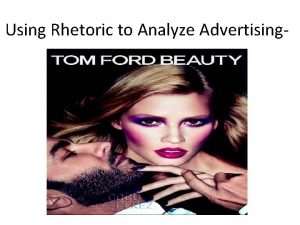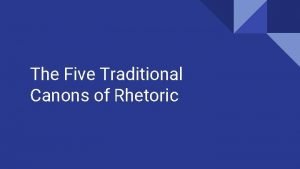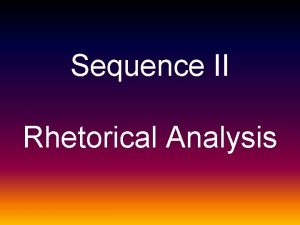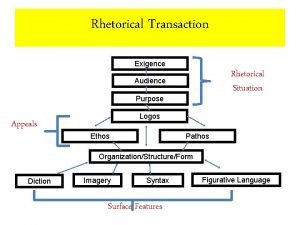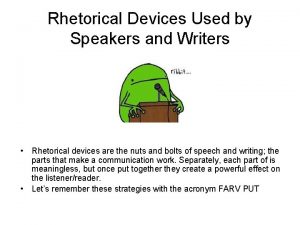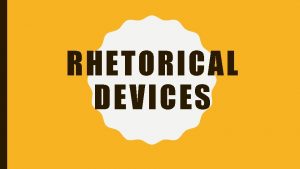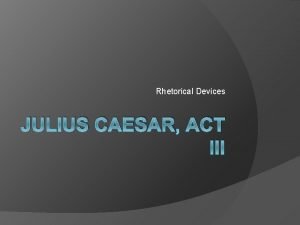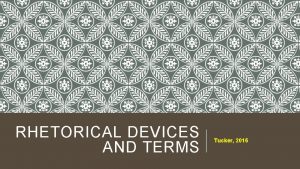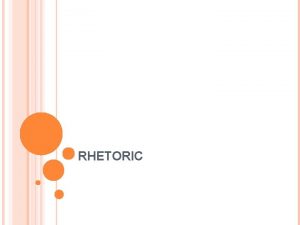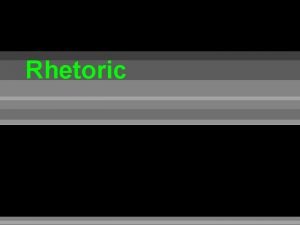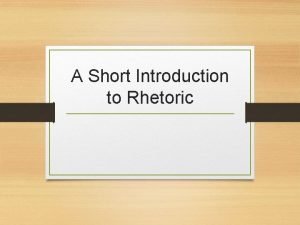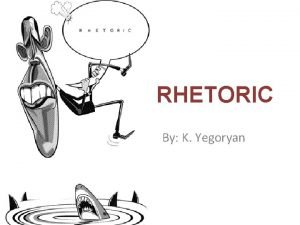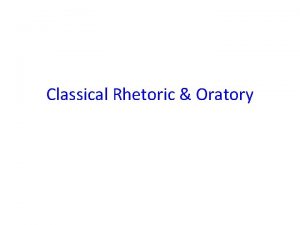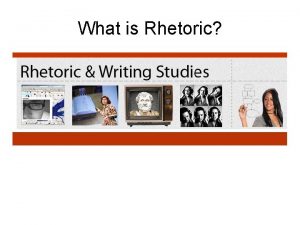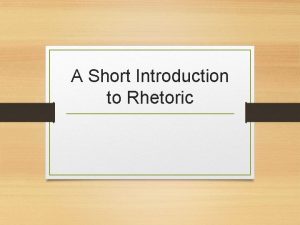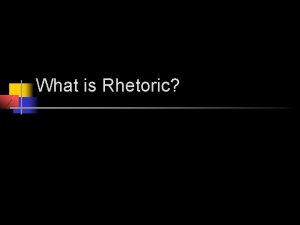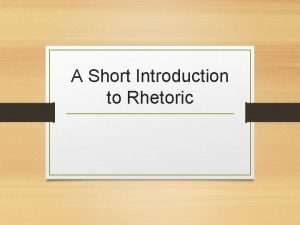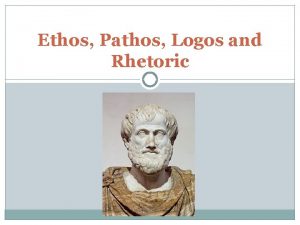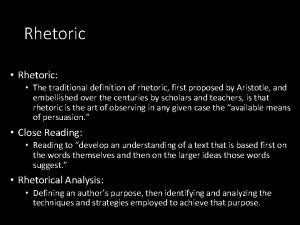RHETORIC Rhetoric The art of analyzing all the




















- Slides: 20

RHETORIC

Rhetoric: The art of analyzing all the language choices that writer, speaker, reader, or listener might make in a give situation so that the text becomes meaningful, purposeful, and effective The specific features of texts, written or spoken, that cause them to be meaningful, purposeful, and effective for readers or listeners in a given situation

WHAT DOES “BEING SKILLED AT RHETORIC” MEAN? Being able to make good speeches and write good papers; also being able to read other people’s compositions and listen to their spoken words with a discerning eye and a critical ear Reading not only to understand the main and supporting points of what someone writes but also to analyze the decisions the rhetor makes as he or she works to accomplish and purpose for a specific audience

Being able to plan and write compositions, not just write them Being able to examine a situation – in school, in your community, in society as a whole – and determine what has already been said and written, what remains unresolved, and what you might say or write to continue the conversation or persuade readers to take action

STYLES TO THINK ABOUT: You might open your paper with a surprising question or quotation. You might challenge your readers’ assumptions about a topic You might write a long, complicated sentence followed by a short, abrupt one You might rely on complex, carefully selected vocabulary that will show your reader you have an in-depth knowledge of the subject you’re writing about

DEVELOPING SKILL WITH RHETORIC: THE RHETORICAL TRIANGLE The rhetorical triangle (a. k. a Aristotelian triad) suggests that a person creating or analyzing a text must consider three elements: The subject and the kinds of evidence used to develop it The audience – their knowledge, ideas, attitudes, and beliefs The character of the rhetor – in particular, how the rhetor might use his or her personal character effectively in the text

Speaker/writer Rhetorical Triangle/ Aristotlean Triad Audience Subject

The rhetor creates a persona – literally a “mask” but figuratively the characteristic he or she wants the audience to perceive himself or herself as Pick the bits of evidence or proof you think is most compelling and persuasive to your audience about your subject Members of the audience will also use their ability to reason – to put together evidence logically – and they are persuaded by the strength of the evidence presented about the subject. They will also be making judgments and thoughts together about you

6 KEYS TO DEVLOPING SKILL WITH RHETORIC

KEY #1: UNDERSTANDING PERSONA A rhetor who understands persona can do two things: � Speak or write so that the audience perceives him/her as a distinct character who is educated, considerate, trustworthy, and well intentioned � Make inferences and judgments about the character and personality of another writer or speaker, analyzing how that writer appeals to the audience, invites the audience to interact with current or historical events, and wants the audience to act after they have finished reading or listening to the text

Writers usually want the persona they develop and the voice they use to be genuine, to reflect who they really are Sometimes they use the mask of another voice for comic effect or to underscore the seriousness of a position they believe in

Using the term persona, Aristotle referred to the character that readers could discern from the writer’s or speaker’s use of words, arrangement of ideas, and choice of details Persona was the mask that a Greek actors wore when they performed Today the word is used to show the artfulness of the speaker’s creation of voice, how deliberately the speaker should select words, tell a story, and repeat phrases in order to help listeners hear the voice that the speaker has decided will be most effective “The mask you wear as a writer doesn’t hide you from your readers – it meets them head on and interacts with them purposefully and effectively”

KEY #2: UNDERSTANDING APPEALS TO THE AUDIENCE: LOGOS, PATHOS, ETHOS A text becomes rhetorical only when an audience reads or hears it and responds to it Therefore, a key to developing skill with rhetoric is understanding how a text appeals to an audience As Aristotle taught his students to discuss and create speeches about important issues, he developed a system that explained to his students how to locate the “available means of persuasion” as they developed their personae (plural), understood the needs and the knowledge and experience of their hearers, and researched and developed their topics Rhetoric, he argued, could help students accomplish their aims as they spoke, primarily to persuade hearers to a course of actions based on a common search for truth

KEY #3: UNDERSTANDING SUBJECT MATTER AND ITS TREATMENT To be a good person speaking well, you must develop skill in treating the subject matter fairly, fully, and effectively in a text.

Must understand four essential concepts 1 – one needs to recognize that any topic, proposition, questions, or issue that might generate the subject of a text must offer at least two paths of interpretation, analysis, or argument – the subject must be an open one. A topic is never a good one if everyone already agrees on it!

2 – a successful rhetor generates effective material by capitalizing on what his or her audience already knows, making them curious to know more about the topic, and then satisfying their curiosity by providing facts, ideas, and interpretations that build on what they already know.

• 3 & 4– a rhetor needs to understand his claim plus support – must generate ample, substantial material to support the points you want to make. This is also known as thesis statement

KEY #4: UNDERSTANDING CONTEXT An effective rhetor knows how to refer to context to help the audience understand the position he or she takes and to connect positively with the text’s argument

KEY #5: UNDERSTANDING INTENTION This is your aim or purpose. It’s what you want to happen as a result of the text, what you want the audience to believe or do after hearing or reading the text You may make your intentions clear from the very beginning or it may become clear as the paper goes on

KEY #6 –UNDERSTANDING GENRE What type of writing will you do to make your point? A five paragraph essay is not the only type of writing!!! Then Read Editorial on pg 22 and analyze its effectiveness � Break down their argument using the 6 keys then jot down how you would respond using the 6 keys – don’t actually write it out, do it in bullet point format
 Analyzing visual rhetoric
Analyzing visual rhetoric Ethos pathos logos plato
Ethos pathos logos plato Rhetoric: the art of persuasive writing and public speaking
Rhetoric: the art of persuasive writing and public speaking Rhetoric is the art of
Rhetoric is the art of Rhetoric the art of persuasion
Rhetoric the art of persuasion The art of speaking and writing effectively
The art of speaking and writing effectively Name
Name Give the nine criteria for analyzing and judging art
Give the nine criteria for analyzing and judging art Analyzing art
Analyzing art You eat what you touch
You eat what you touch What is rhetoric
What is rhetoric An author's purpose in using rhetoric is to
An author's purpose in using rhetoric is to What is rhetoric
What is rhetoric 3 types of rhetoric
3 types of rhetoric Canons of rhetoric
Canons of rhetoric Five classical canons of rhetoric
Five classical canons of rhetoric Rhetorical transaction definition
Rhetorical transaction definition Tricolon
Tricolon Rhetoricl devices
Rhetoricl devices Antistrophe example
Antistrophe example Is allegory a rhetorical device
Is allegory a rhetorical device
